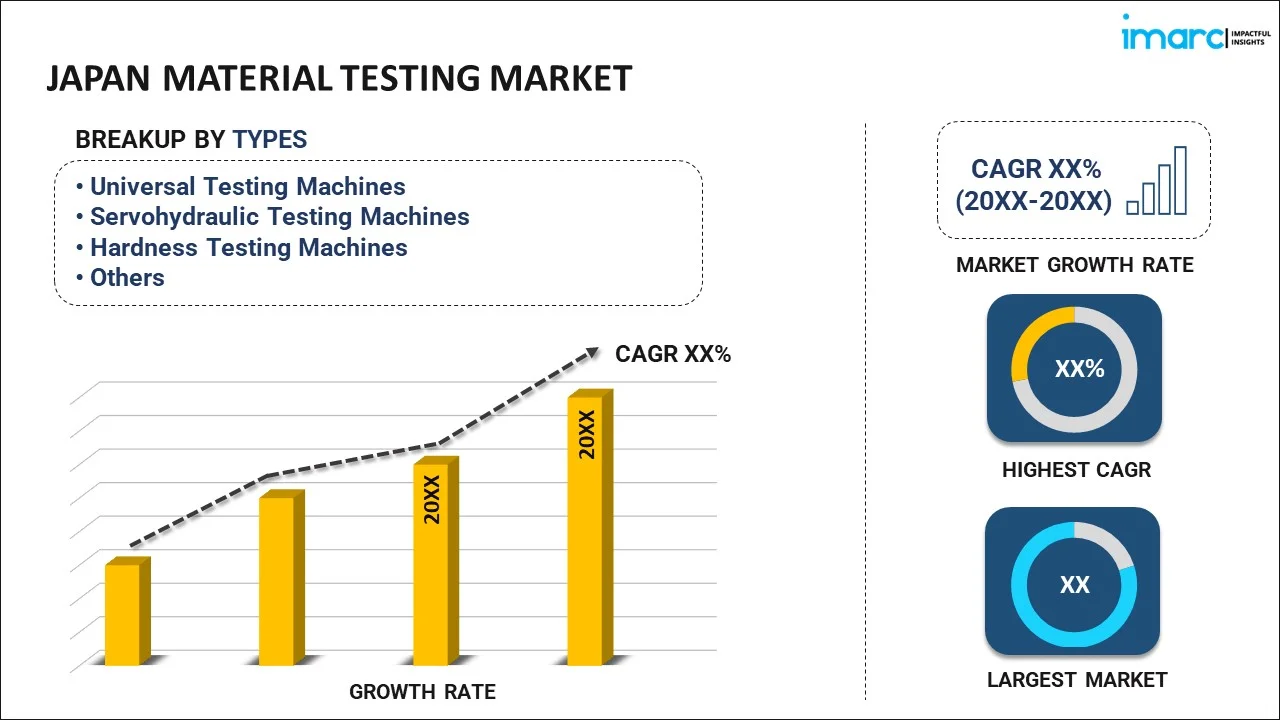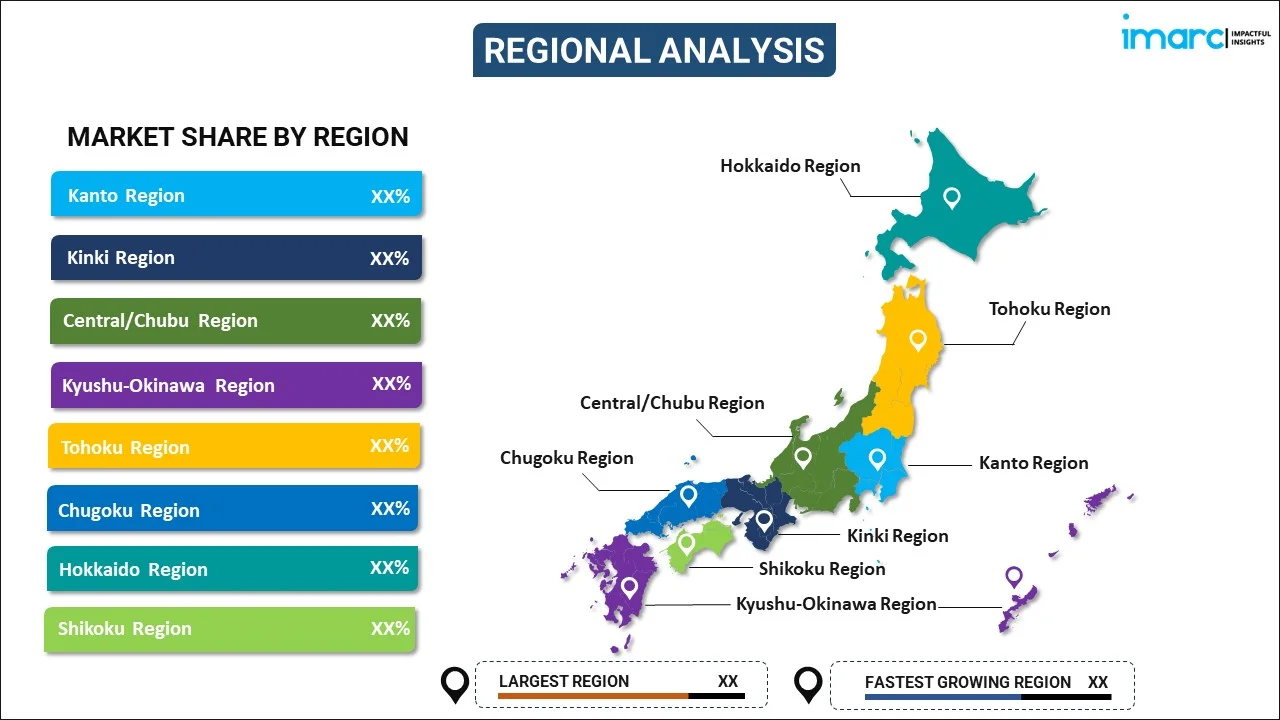
Japan Material Testing Market Report by Type (Universal Testing Machines, Servohydraulic Testing Machines, Hardness Testing Machines, Impact Testing Machines, Non-Destructive Testing Machines), Material (Metals and Alloys, Plastics, Rubber and Elastomers, Ceramics and Composites, and Others), End Use Industry (Automotive, Construction, Education, Aerospace and Defense, Oil and Gas, Energy and Power, and Others), and Region 2025-2033
Market Overview:
The Japan material testing market size reached USD 428.8 Million in 2024. Looking forward, IMARC Group expects the market to reach USD 589.5 Million by 2033, exhibiting a growth rate (CAGR) of 3.42% during 2025-2033.
|
Report Attribute
|
Key Statistics
|
|---|---|
|
Base Year
|
2024
|
|
Forecast Years
|
2025-2033
|
|
Historical Years
|
2019-2024
|
| Market Size in 2024 | USD 428.8 Million |
| Market Forecast in 2033 | USD 589.5 Million |
| Market Growth Rate (2025-2033) | 3.42% |
Material testing refers to a technique used to measure the physical and mechanical properties of raw composite materials and components, such as ceramics, plastics, and metals, under different conditions. It is performed in laboratories or research institutes to analyze the performance and measure the optimal condition of products based on their elongation, compression, tensile strength, and ductility. Several manufacturers operating in Japan are nowadays launching innovative machines and instruments that can make accurate and repeatable force measurements.
Japan Material Testing Market Trends:
Significant growth in the construction industry, coupled with the increasing demand for improving and maintaining the quality of ceramics and other building products, represents one of the key factors driving the market in Japan. Apart from this, the rising adoption of material testing in the automotive industry to ensure material strength and offer optimal performance is contributing to the market growth. In addition to this, due to the growing food safety concerns across the country, material testing is gaining traction in the food and beverage (F&B) industry to enhance the safety of packaged products and minimize the risk of contamination.
Key Market Segmentation:
IMARC Group provides an analysis of the key trends in each segment of the Japan material testing market report, along with forecasts at the country and regional levels from 2025-2033. Our report has categorized the market based on type, material and end use industry.
Breakup by Type:

- Universal Testing Machines
- Servohydraulic Testing Machines
- Hardness Testing Machines
- Impact Testing Machines
- Non-Destructive Testing Machines
Breakup by Material:
- Metals and Alloys
- Plastics
- Rubber and Elastomers
- Ceramics and Composites
- Others
Breakup by End Use Industry:
- Automotive
- Construction
- Education
- Aerospace and Defense
- Oil and Gas
- Energy and Power
- Others
Breakup by Region:

- Kanto Region
- Kinki Region
- Central/ Chubu Region
- Kyushu-Okinawa Region
- Tohoku Region
- Chugoku Region
- Hokkaido Region
- Shikoku Region
Competitive Landscape:
The competitive landscape of the industry has also been examined along with the profiles of the key players.
Report Coverage:
| Report Features | Details |
|---|---|
| Base Year of the Analysis | 2024 |
| Historical Period | 2019-2024 |
| Forecast Period | 2025-2033 |
| Units | Million USD |
| Segment Coverage | Type, Material, End Use Industry, Region |
| Region Covered | Kanto Region, Kinki Region, Central/ Chubu Region, Kyushu-Okinawa Region, Tohoku Region, Chugoku Region, Hokkaido Region, Shikoku Region |
| Customization Scope | 10% Free Customization |
| Post-Sale Analyst Support | 10-12 Weeks |
| Delivery Format | PDF and Excel through Email (We can also provide the editable version of the report in PPT/Word format on special request) |
Key Questions Answered in This Report:
- How has the Japan material testing market performed so far and how will it perform in the coming years?
- What has been the impact of COVID-19 on the Japan material testing market?
- What are the key regional markets?
- What is the breakup of the market based on the type?
- What is the breakup of the market based on the material?
- What is the breakup of the market based on the end use industry?
- What are the various stages in the value chain of the industry?
- What are the key driving factors and challenges in the industry?
- What is the structure of the Japan material testing market and who are the key players?
- What is the degree of competition in the industry?
Need more help?
- Speak to our experienced analysts for insights on the current market scenarios.
- Include additional segments and countries to customize the report as per your requirement.
- Gain an unparalleled competitive advantage in your domain by understanding how to utilize the report and positively impacting your operations and revenue.
- For further assistance, please connect with our analysts.
 Inquire Before Buying
Inquire Before Buying
 Speak to an Analyst
Speak to an Analyst
 Request Brochure
Request Brochure
 Request Customization
Request Customization




.webp)




.webp)












